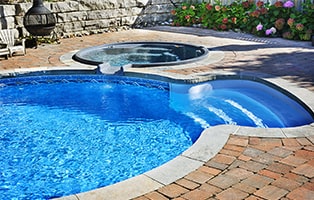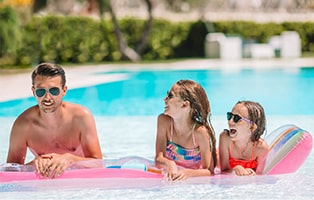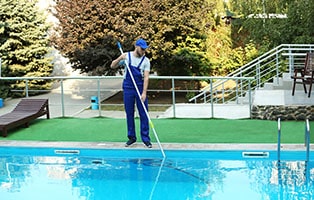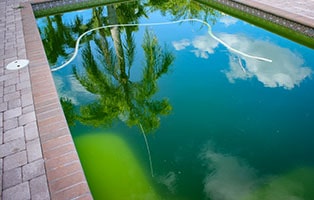Here’s everything you need to know about pool water chemistry to keep your pool safe and sanitary
Balancing your pool water means you have the right combination of chemicals for optimal sanitization. That way, your pool won’t adversely affect swimmers or damage equipment or surfaces.
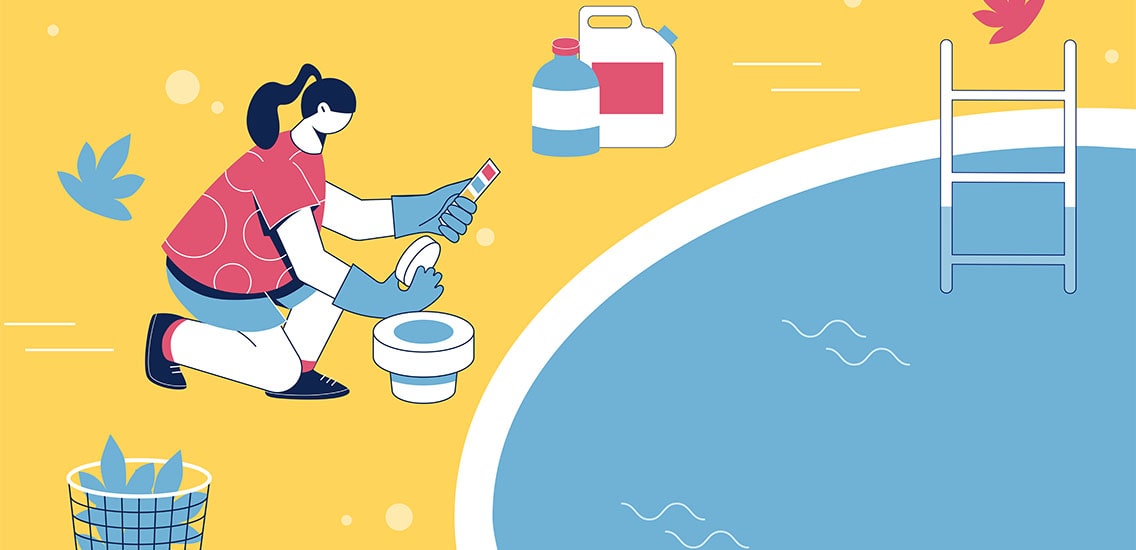
The chemistry in your pool is in constant flux. Weather, oils, dirt, cosmetics, and a hundred other factors affect its sensitive balance. Filtration and disinfecting might remove contaminants but won’t do a thing to balance your water chemistry.
Proper Pool Chemistry
If you’re a new pool owner, test your water daily. Once you gain more pool experience, you can monitor it less.
pH
pH is the most crucial pool chemical scale. It measures how acidic or basic pool water is and is a logarithmic scale that goes from 0 to 14, with 7 being neutral. A pH under 7 is considered acidic, while a level above 7 is basic (or alkaline).
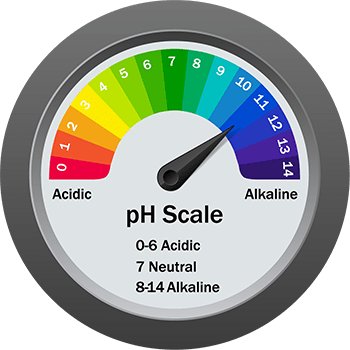
How to adjust pH
If your testing indicates a level below 7.2, your water is acidic, which can cause corrosion. To raise pH, use soda ash or borax. If the pH is above 7.8, the water is basic. Add muriatic acid to prevent scale formation.
Over time, pH levels tend to creep upwards. Aerating the water — whether because you have a water aeration feature or due to rain — can cause levels to shoot skyward.
Adverse Effects
Your water needs to be kept in balance to prevent eye irritation and other adverse effects and protect pool equipment from getting ruined. pH levels below 7.2 can cause a stinging sensation in swimmers’ eyes. pH levels below 6.8 can damage metal parts—especially pool heaters with copper heat exchange coils. High levels lead to scaling.
Alkalinity
Alkalinity measures alkaline substances in water, including carbonates, bicarbonates, and hydroxides. It’s defined as the ability of the water to resist changes in pH, otherwise known as buffering capacity.
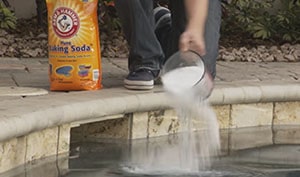
Alkalinity keeps pH levels from bouncing all over the place. It should be maintained in the 80 to 120 ppm range for gunite and concrete pools and 100 to 140 ppm for painted, vinyl, and fiberglass pools.
Add baking soda a little at a time to increase alkalinity. Test the water each time you do because baking soda can raise pH levels, and you don’t want the pH going out of range.
Let’s say your pool water is a little murky, or your pool filters seem to be plugged with calcium deposits. In that case, your pool may be suffering from high alkalinity levels. To decrease alkalinity, use muriatic acid.
Free Chlorine
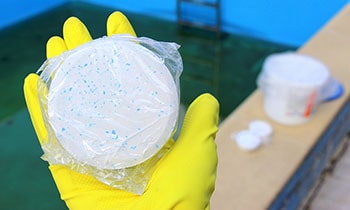
Free chlorine, or FC, is a sanitizer that keeps your pool free of germs. Sunlight breaks down FC. Maintaining the correct levels of free chlorine is the most crucial part of keeping your water balanced. If you allow FC to get too low, you run the risk of algae proliferating in your pool, and it won’t be safe to swim in.
Test your FC daily. If you have an automatic chlorinator, you only need to check it every couple of days. The level of FC you need to maintain depends on the cyanuric acid level and how often you use your pool. Raise free chlorine levels using household bleach, liquid chlorine, or by using a saltwater chlorine generator.
Combined Chlorine
Combined chlorine, or CC, is responsible for the chlorine smell many associate with pools. The presence of CC means FC is in the process of breaking down organic materials.
If your CC is above 0.5 parts per million (ppm), you’re going to need to SLAM (Shock, Level, and Maintain) your pool ASAP. CC will typically stay at or near zero in an outdoor pool if you maintain balanced FC levels and the pool gets plenty of sunlight.
Calcium Hardness
Calcium hardness, or CH, is the amount of calcium in your pool water. Too much, and you end up with cloudy water and ugly calcification. Too little and your pool water will eat the calcium in the surface of your pool, damage fittings, and cause staining.
The recommended range for calcium hardness is 220 to 400 ppm. By testing for calcium hardness, you’ll find out how hard or soft your water is. Hard water has high amounts of calcium (and magnesium), and soft water has low amounts.
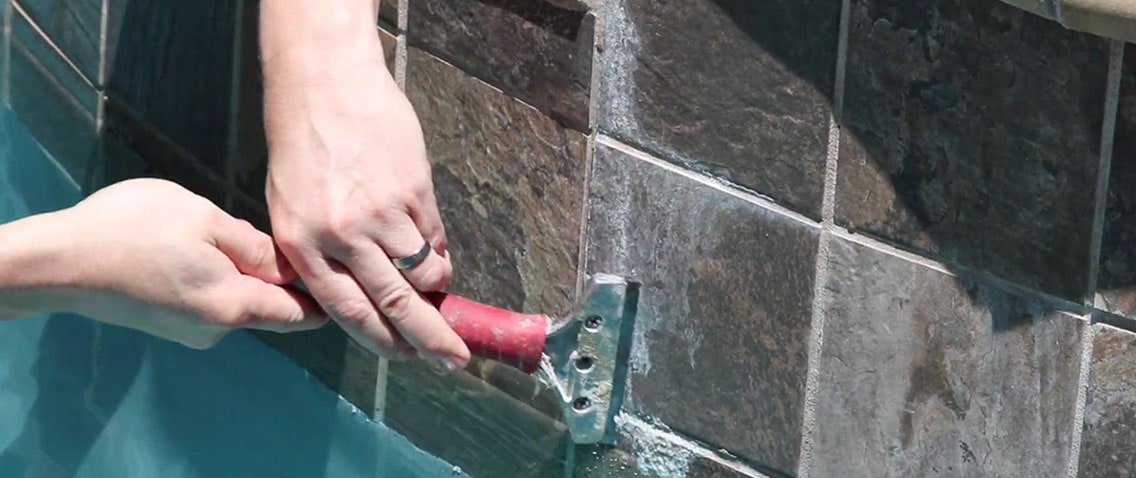
Under-saturated vs. Over-saturated
Because water low on calcium is under-saturated, it will aggressively try to get the calcium it needs by any means necessary. This includes corrosion of pool surfaces containing calcium. Over time, low calcium water leaches the mineral from plaster, pebble, tile, stone, concrete, and fiberglass surfaces. Prevent this from happening by keeping your pool water always saturated with calcium.
Over-saturated water can also cause problems. For example, in a vinyl pool liner, there’s no need for calcium. However, water high in calcium tries to get rid of excess calcium particles. These particles seek to deposit themselves on any pool surface they can find. This results in plaster damage and scaling. Scaling is calcium carbonate that crystallizes as rough whitish spots.
Calcium Levels for Different Types of Pools
If you have a plaster or fiberglass pool, always keep your calcium between 250 and 650 ppm. If you have a spa, keep the levels between 100 and 150 ppm to reduce foaming.
If your calcium levels are too low, add calcium chloride. This is sold as a deicer in big box stores. You can also buy it in pool stores as a commercial product. If your CH levels are too high, use TSP (Trisodium Phosphate), dilute your water, or have a reverse osmosis treatment done.
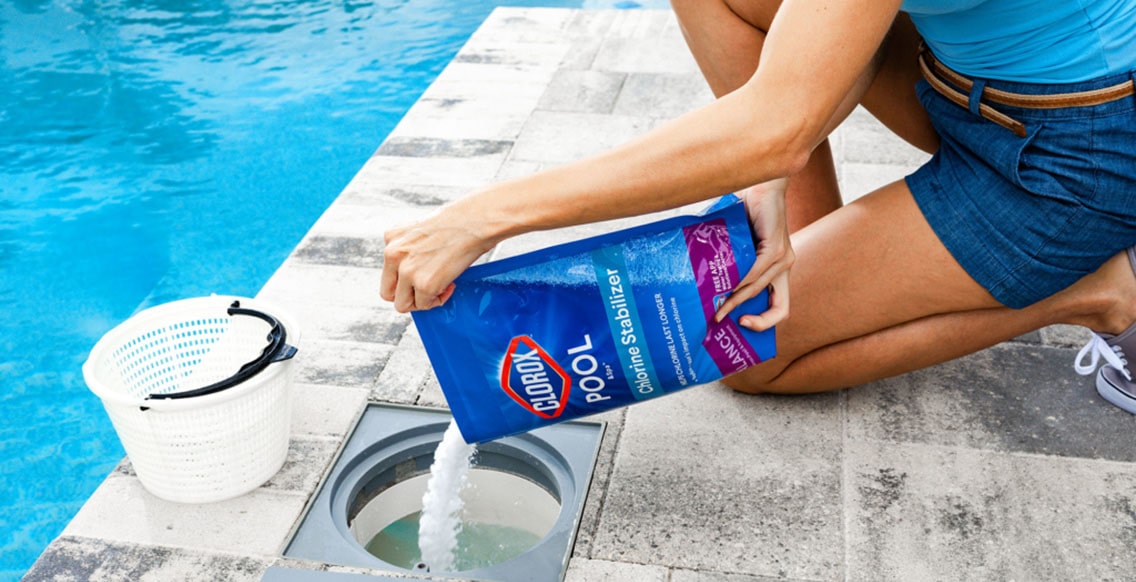
Cyanuric acid, or CYA, protects free chlorine from sunlight. If you have a saltwater chlorine generator or your pool is exposed to lots of direct sunlight, you want to maintain a CYA level between 70 and 80 ppm. If you don’t own a saltwater chlorine generator, your CYA levels should be between 30 and 60 ppm.
If you’re using granular CYA, place it in a sock. Then, put it into the skimmer basket. You can also suspend it in front of a pool return jet. After adding CYA, leave the pump running for 24 hours and don’t backwash or clean the filter for a week. Periodically squeezing the sock will help it to dissolve faster. You can test CYA the day after it’s fully dissolved.
In most cases, the best way to lower CYA is by dilution.
Salt
Of course, if you have a saltwater generator, you’re going to need to add salt. Check the manual to see how much you should add. This level is usually around 3,000 ppm.
You can use solar salt, which is sold as a water softener. You’ll need the kind that’s 99.4% pure and that doesn’t have a rust inhibitor or other additives. Crystals work fine. Pellets work but dissolve more slowly.
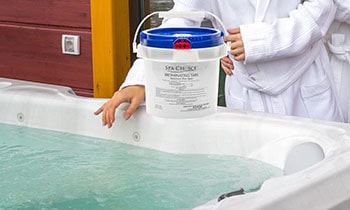
Bromine
Bromine is chemically like chlorine and has a similar effect. However, it doesn’t have the same strong chlorine smell, making it super popular for hot tubs and spas. Its sanitization power also lasts longer than chlorine.
Ozone
Ozone is an effective sanitizer that’s produced by a generator attached to your pump or circulation system. It’s usually used as a backup for a primary sanitizer like chlorine. Unfortunately, it has a short lifespan in water.
Final Thoughts
Balancing your pool water isn’t some sort of complex chemistry experiment. By following a few simple rules, you can keep the chemicals in your pool water exactly where they’re supposed to be.
That way, you protect the health of swimmers while making sure that equipment and pool surfaces aren’t damaged.

Pool Maintenance Tips & Tricks
